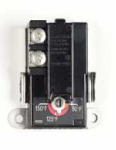
One simple step for reducing water-heating energy costs is lowering the thermostat setting on your water heater. Although some manufacturers set water heaters at 140 degrees F (60 degrees C), 120 degrees F (48.9 degrees C) is satisfactory for most household needs. Furthermore, when heated to 140 degrees F, water can pose a safety hazard (i.e., scalding). For each 10 degrees F (5.6 degrees C) reduction in water temperature, water-heating energy consumption can be reduced 3% to 5%.
 |
If your dishwasher does not have a booster heater, lowering the
water-heating temperature is not recommended. Also, many dishwasher detergents are
formulated to clean effectively at 140 degrees F and may not perform adequately at lower
temperatures. On gas water heaters, thermostats are usually visible. Electric water heaters, on the other hand, may have thermostats positioned behind screw-on plates. As a safety precaution, shut off electric current to the water heater before removing the plates. Keep in mind that electric water heaters may have two thermostats to adjust--one each for the upper and lower heating elements—and adjusting these is tricky. Talk to your local water-heating professional for help with this. |
When you plan to be away from home for an extended period of time (at least 3 days), turning the water heater thermostat down to the lowest setting, or even turning the heater off completely, can help you achieve additional savings. Be sure you know how to relight the pilot light on your gas heater, though, before you turn it off.
Email Us for more energy efficiency information or to speak with a Personal Energy Advisor call, 1-800-562-1482.
|
|
|
| Copyright © Aclara Technologies LLC. All Rights Reserved. | |